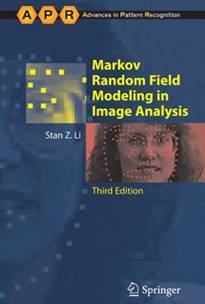|
Markov Random Fields (MRF) is a mature region in the area of probability theory that finds applications in various signal processing and pattern recognition tasks MRF provides solutions to these tasks by building mathematical models using intrinsic characteristics of the underlying signal under some specific and well defined assumptions related to the nature of signal generation mechanism. Prof. Li�s book in MRF modeling for image analysis provides a comprehensive introduction to the area of MRF in general and to its applications in image processing in specific. The areas of interest are divided into two groups. One dealing with low-level tasks such as observation models; image restoration and reconstruction; and texture synthesis, analysis and segmentation. The second group deals with high-level tasks such as object-matching, recognition, and pose estimation. The book is very well written with a plethora of references for the reader that wants to delve further into specific areas. But the reader needs to be warned that some sections of the book are rather dense and are not intended for novice practitioners in the area. Chapter 1 describes class labeling issues in image analysis and also gives a general review of various optimization approaches. The chapter closes with a thorough introduction in Bayes estimation theory and the maximum a posteriori (MAP)-MRF framework. A common problem in stochastic modeling is the computational complexity for model generation. This issue is addressed in Chapter 2 which introduces the reader to the world of MRF and Gibbs distributions and, after presenting a brief proof on their equivalence, proceeds to show various types of models, among them multilevel logistic, multiresolution, hierarchical, k-MRF, and Nakagami models. The chapter closes with an equally import topic which is the smoothness assumption and the methods for assessing its energy content. The next two chapters deal with low- and high-level MAP-MRF for image processing. There is extensive coverage on image restoration and reconstruction problems from noise-added surfaces under the smoothness condition. Then the focus passes from edge labeling problems�again under the smoothness constraint�to texture generation (modeling) where Metropolis and Gibbs samplers are introduced for texture segmentation. Optical flow and stereo vision problems are addressed using pixel labeling. Finally, Bayesian deformable models are described and extensive coverage is given to the EigenSnake algorithm along with an example on a face detection application. Object matching and pose estimation (high-level models) are examined under conditional constraints, at first, and subsequently using feature extraction. Multiple objects are also treated. This is a more realistic scenario but requires additional constraints, namely between- and within-objects. Chapter 5 presents a realistic scenario where the smoothness assumption does not hold. Uniformity over the entire surface is non-realistic and undesirable along discontinuities. A regularization framework is introduced that punishes irregularities given a priori smoothness constraints. Other models presented in the chapter are the Discontinuity Adaptive (DA)-MRF model under the Euler equation and the set of variants to the standard Total Variation (TV) model. The next two chapters deal with the core problem in MRF models which is parameter estimation. Firstly, the problem of outliers in the data is addressed using robust statistical methods such as M-estimator and its variant AM-estimator using annealing. Next, maximum likelihood (ML) parameter estimation is presented both for MRF and noise modeling. Computational complexities in ML are dealt with:� pseudo-likelihood, mean field approximations, and least squares, among others. The issue of complexity is amplified in complex scenes with unlabeled data. For this reason, various solutions are proposed, among them the well-known Expectation-Maximization (EM) algorithm. The chapter closes with methods for estimating the number of MRF's. What follows is a fine-tuning of the parameter estimation, presented earlier, for object recognition. Various criteria are presented (correctness, instability, and optimality) and estimators are given in a global energy minimization approach. Dimensionality reduction is also addressed. The problem of finding a closed functional form for the optimal solution is discussed in chapter 9. Iterative techniques for finding local minima are given. Conditional modes under independence and Markovian assumptions are investigated. Minimization in discrete space is introduced using the relaxation labeling method. Dynamic and quadratic programming are also engaged in an effort to describe the global energy function. Finally Lagrange multipliers, Hopfield NN, and their combination are presented. The last chapter of the book deals again with minimization issues but from a global perspective. Simulated annealing is introduced. Following is the mean field annealing which replaces the minimization of the MRF's energy function with the evaluation of the mean field. Another annealing alternative technique covered is graduated nonconvexity. Moreover graph cuts and genetic algorithms are discussed for labeling problems. The chapter closes with an extensive set of experimental results for various algorithms covered earlier in the book. In conclusion, this book is very thorough, both in a mathematic and a descriptive manner. Anyone interested in image processing and its applications under an MAP-MRF setting can benefit from the variety of provided examples and its wide range of references. |


|
BOOKSBOOKSBOOKS
Markov Random Field Modeling in Image AnalysisBy Stan Z. Li Springer, 2009
Reviewed by Apostolos Georgakis (Sweden) |
|
Click above to go to the publisher�s web page for this book where you will find a description, contents, and sample pages. |
